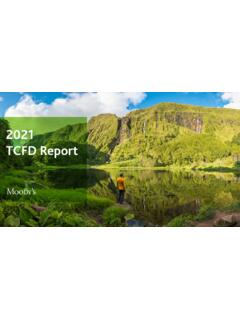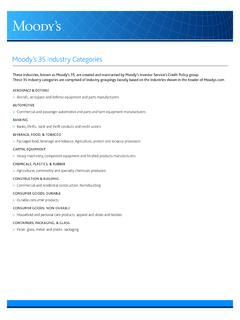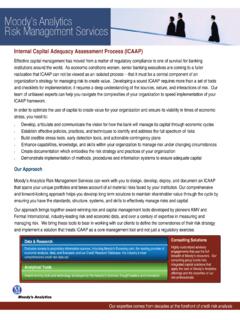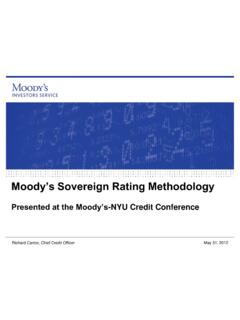Transcription of Moody’s Rating System in Brief - Moody's Investors Service
1 12 M A RCH 20 0 9R AT I N G S YS T E M I N B R I E FWhat is a Rating ?A Rating is moody s opinion of the credit quality of individual obli-gations or of an issuer s general a Rating is are not recommendations to buy or sell, nor are they a guar-antee that default will not do the capital markets use ratings? Investors use ratings to help price the credit risk of fixed-income securities they may buy or sell. Many also use ratings as limits on their investment parameters and as means for expanding their investment horizons to markets or security types they do not cover by their own analysis. Because major Investors globally rely on moody s ratings, the ratings help to provide issuers of debt with stable, flexible access to those sources of types of securities does moody s rate?
2 Any type of debt or related obligation of interest to institutional Investors , , bonds, debentures, asset-backed and mortgage-backed securities, convertible bonds, medium-term notes, derivative securities, etc. What do credit ratings measure? moody s credit ratings represent a rank-ordering of creditworthi-ness, or expected loss. Expected loss is a function of the probability of default and the expected severity of loss given a default. Ratings are forward looking in that the rank ordering is designed to hold across multiple a Rating summarizes the credit risk characteristics of an obli-gor or obligation, it is not a statement as to which obligors or obli-gations will default in the future.
3 Rather, it is expected that lower rated entities and obligations will default, on average, at a higher frequency than more highly rated entities and is moody s Rating process?The Rating process: gathers information sufficient to evaluate risk to Investors who might own or buy a given security, develops a conclusion in committee on the appropriate Rating , monitors on an ongoing basis to determine whether the Rating should be changed, and informs the marketplace and market participants of moody s does a moody s Rating committee work? moody s ratings are initially determined or subsequently changed through committee. The lead analyst for a given company, indus-try, country, or asset type frames the discussion, including offering the Rating recommendation and its minimum, the committee includes a managing director or other designated individual and the lead analyst.
4 The committee may be expanded to include as many perspectives and disciplines as are needed to address all analytical issues relevant to the issuer and the security being affecting the size of the committee may include the size of the issuer, complexity of the security, geography, or whether a transaction of the type has ever been done before. The discus-sions of the committees are strictly confidential, and only moody s analysts may serve on a s Rating System in Brief12 M A RCH 20 0 9 AMERICAS+ more information, please contact your sales representative or call:What sources of information do analysts use? Publicly available data, , annual reports. Prospectuses, offering circulars, offering memoranda, trust deeds, or indentures of particular securities.
5 Market data, , stock price trends, trading volume, data on bond price spreads. Economic data from industry groups, associations or bodies, such as the World Bank. Data from agencies, such as central banks, ministries, or regulators. Books or articles from academic sources, financial journals, news reports. Discussions with expert sources in industry, government, or academia. Data that may come from meetings or conversations with the debt issuer. If the data are confidential, moody s strictly observes long has the Rating System been in use?John moody introduced ratings to the bond market in 1909 when he published the first debt ratings in his Manual of Railroad does the probability of default change as one moves down the Rating scale?
6 The historic default rate for Aaa-rated obligors is negligible, across all horizons. As one moves down the Rating scale, default risk rises. Obligors rated in the lowest Rating categories may in fact be in definitions pertaining to the Rating process: Rating outlooks: These are opinions regarding the likely direc-tion of an issuer s Rating over the medium term. Rating out-looks fall into the following four categories: Positive, Negative, Stable, and Developing (Contingent upon an event), Rating review/watchlist: A credit is placed on the watchlist when it is on review for possible upgrade, or on review for possible downgrade, or (more rarely) on review with direction uncertain.
7 moody s will attempt to conclude a formal review within 90 is moody s Rating scale?The Rating scale, running from a high of Aaa to a low of C, comprises 21 notches. It is divided into two sections, investment grade and speculative grade. The lowest investment-grade Rating is Baa3. The highest speculative-grade Rating is Debt Ratings (maturities of one year or greater)I N V E S T M E N T G R A D E Aaa highest Rating , representing minimum credit risk Aa1, Aa2, Aa3 high-grade A1, A2, A3 upper-medium grade Baa1, Baa2, Baa3 medium gradeS PEC U L AT I V E G R A D E Ba1, Ba2, Ba3 speculative elements B1, B2, B3 subject to high credit risk Caa1, Caa2, Caa3 bonds of poor standing Ca highly speculative, or near default C lowest Rating , bonds typically in default, little pros-pect for recovery of principal or interestShort-Term Debt Ratings (maturities of less than one year) Prime-1 (highest quality)
8 Prime-2 Prime-3 Not Prim










